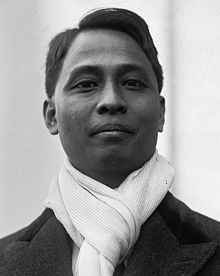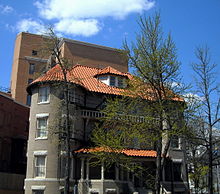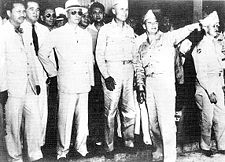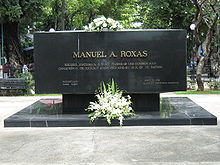- Manuel Roxas
-
This article is about the Filipino president. For grandson, see Mar Roxas. For the municipality, see Pres. Manuel A. Roxas, Zamboanga del Norte. For other places that now bear his name, see Roxas (disambiguation).
Manuel Roxas 
5th President of the Philippines
3rd President of the Commonwealth
1st president of the Third RepublicIn office
May 28, 1946 – April 15, 1948Vice President Elpidio Quirino Preceded by Sergio Osmeña Succeeded by Elpidio Quirino 2nd President of the Senate of the Philippines In office
July 9, 1945 – May 25, 1946President Sergio Osmeña Preceded by Manuel L. Quezon Succeeded by Jose Avelino Senator of the Philippines In office
July 9, 1945 – May 25, 19462nd Speaker of the Philippine House of Representatives In office
1922–1933Preceded by Sergio Osmeña Succeeded by Quintin Paredes Member of the Philippine House of Representatives from Capiz' 1st District In office
1921–1938Preceded by Antonio Habana Succeeded by Ramon A. Arnaldo Personal details Born January 1, 1892
Capiz, Philippines (now Roxas City)Died April 15, 1948 (aged 56)
Clark Air Base, PhilippinesResting place Manila North Cemetery, Santa Cruz, Manila, Philippines Political party Liberal Party (1945–1948) Other political
affiliationsNacionalista Party (Before 1945) Spouse(s) Trinidad de Leon Alma mater University of Manila
University of the Philippines College of LawProfession Lawyer Religion Roman Catholicism Signature 
Manuel Acuña Roxas (January 1, 1892 – April 15, 1948) was the first president of the independent Third Republic of the Philippines and fifth president overall. He served as president from the granting of independence in 1946 until his abrupt death in 1948. His term as president of the Philippines was also the shortest, lasting 1 year 10 months and 18 days.
Contents
His Early life and career
Manuel A. Roxas, third and last President of the Commonwealth and the first of the Republic of the Philippines, was born to Gerardo Roxas, Sr. and Rosario Acuña on January 1, 1892 in Capiz (now Roxas City). He was a posthumous child, for his father Gerardo had been mortally wounded by Spanish guardias civiles the year before, leaving him and his older brother Mamerto to be raised by their mother and Don Eleuterio, their maternal grandfather.
Roxas received his early education in the public schools of Capiz, and at age 12, attended St. Joseph’s Academy in HongKong. But after homesickness, he went back to Capiz. He eventually moved to Manila High School (later named the Araullo High School), graduating with highest honors in 1909.
Roxas began his law studies at a private law school established by George Malcolm, the first dean of the University of the Philippines College of Law. On his second year, he enrolled at U.P., where he was elected president of both his class and the Student Council. In 1913, Roxas obtained his law degree, graduated class valedictorian, and subsequently topped the first bar examinations with a grade of 92%, becoming the first ever bar topnotcher of the Philippines.
Congressional career
House of Representatives
Roxas occupied more important positions in the Philippine government than any other Filipino had ever held before him. For some thirty-six years he exercised authority as public official in various capacities, capping these with the highest office in the land. Starting in 1917 as a member of the municipal council of Capiz, he became the youngest governor of his province and served in this capacity from 1919 to 1922. The Roxas potential for national leadership became evident when he was elected President of the national league of governors during his term as provincial head.
He was later elected to the Philippine House of Representatives in 1922, and for twelve consecutive years was Speaker of the House. He was member of the Constitutional Convention 1934 to 1935, Secretary of Finance, Chairman of the National Economic Council, Chairman of the National Development Company and many other government corporations and agencies, Brigadier General in the USAFFE, and Guerilla leader.
Senate
After the amendments to the 1935 Philippine Constitution were approved in 1941, he was elected (1941) to the Philippine Senate, but was unable to serve until 1945 because of the outbreak of World War II.
Having enrolled prior to World War II as an officer in the reserves, he was made liaison officer between the Commonwealth government and the United States Army Forces in the Far East headquarters of General Douglas MacArthur. He accompanied President Quezon to Corregidor where he supervised the destruction of Philippine currency to prevent its capture by the Japanese. When Quezon left Corregidor, Roxas went to Mindanao to direct the resistance there. It was prior to Quezon's departure that he was made Executive Secretary and designated as successor to the presidency in case Quezon or Vice-President Sergio Osmeña were captured or killed. Roxas was captured (1942) by the Japanese invasion forces.
When the Congress of the Philippines was convened in 1945, the legislators elected in 1941 chose Roxas as Senate President. In the Philippine national elections of 1946, Roxas ran for president as the nominee of the liberal wing of the Nacionalista Party. He had the staunch support of General MacArthur. His opponent was Sergio Osmeña, who refused to campaign, saying that the Filipino people knew his reputation. However, in the April 23, 1946 election, Roxas won 54 percent of the vote, and the Liberal Party won a majority in the legislature. When the Philippines gained independence from the United States on July 4, 1946, he became the first president of the new republic.
Presidential election of 1946
On 1946, at the height of the last Commonwealth elections, subjected for replacing Sergio Osmeña in office, Senate President Roxas and his friends bolted from the Nacionalista Party and founded their own Liberal Party. Roxas then became the standard-bearer for presidency for the Liberal Party and Elpidio Quirino for vice-president. The Nacionalistas, on the other hand, had Osmeña for president and Senator Eulogio Rodriguez for vice-president. On April 23, 1946, Roxas and Quirino won the ticket.
On May 8, 1946, President-elect Roxas, accompanied by US High Commissioner Paul V. McNutt, enplaned for the United States to discuss with the American authorities the vital matters affecting the Philippines. On May 28, 1946, Roxas was inaugurated amidst impressive ceremonies as the last President of the Commonwealth of the Philippines. The inaugural ceremonies were held on the grounds of ruined, shell-blasted Legislative Building and were witnessed by huge crowds of around 200,000 people. He delineated the main policies of his administration, mainly, closer ties with the United States, adherence to the newly-created United Nations Organization, reconstruction of war-devastated country, relief for the masses, social justice to the working class, maintenance of peace and order, preservation of individual rights and liberties of the citizenry and honesty and efficiency of government office.
Presidency
Administration and cabinet
OFFICE NAME TERM President Manuel Roxas 1946–1948 Vice-President Elpidio Quirino 1946–1948 Secretary of Foreign Affairs Elpidio Quirino 1946–1948 Secretary of the Interior José Zulueta 1946–1948 Secretary of Finance Miguel Cuaderno 1946–1948 Secretary of Justice Ramón Ozaeta 1946–1948 Secretary of Agriculture and Commerce Mariano Garchitorena 1946–1948 Secretary of Public Works and Communications Ricardo Nepumoceno 1946–1948 Secretary of Instruction Manuel Gallego 1946–1948 Secretary of Labor Pedro Magsalin 1946–1948 Secretary of National Defense Ruperto Kangleon 1946–1948 Secretary of Health and Public Welfare Antonio Villarama 1946–1948 General Auditing Office Sotero Cabahug 1945–1946 Secretary to the President José S. Reyes 1945–1946 Chief of the Executive Office Emilio M. Abello 1946–1948 Resident Commissioner Carlos P. Romulo 1945–1946 Other appointees
Gedeon G. Quijano
Last President of the Commonwealth (1946)
Roxas served as the President of the Commonwealth of the Philippines in a brief period, from his subsequent election on May 28, 1946 to July 4, 1946, the scheduled date of the proclamation of Philippine Independence. Roxas prepared the groundwork for the advent of a free and independent Philippines, assisted by the Congress (reorganized May 25, 1946), with Senator José Avelino as the Senate President and Congressman Eugenio Perez as the House of Representatives Speaker. On June 3, 1946, Roxas appeared for the first time before the joint session of the Congress to deliver his first state of the nation address. Among other things, he told the members of the Congress the grave problems and difficulties the Philippines are set to face and reports of his special trip to the United States–the approval for independence.[1]
On June 21, he reappeared into another joint session of the Congress and urged the acceptance of two important laws passed by the Congress of the United States on April 30, 1946 to the Philippine lands. They are the Philippine Rehabilitation Act and the Philippine Trade Act.[2] Both recommendations were accepted by the Congress.
First president of the Third Republic (1946–1948)
Manuel Roxas' term as the President of the Commonwealth of the Philippines ended on the morning of July 4, 1946 when the Third Republic of the Philippines was inaugurated and Philippine Independence from the United States proclaimed, amidts plaudits and prayers of some 300,000 people, 21-gun salute and joyous echoes of church bells. Roxas was then inaugurated as the new and first president of the new Republic.
The inaugural ceremonies took place at Luneta Park, Manila. On the grandstand there were around 3,000 guests and notables, consisted of President Roxas and his cabinet; the last US High Commissioner and first American Ambassador of US to the Philippines Paul McNutt; General Douglas MacArthur (coming from Tokyo); United States Postmaster General Robert E. Hannegan; a delegation from US Congress headed by Tydings-McDuffie Act author Maryland Senator Millard Tydings and Missouri Representative C. Jasper Bell, author of Bell Trade Act and former civil governor-general Francis Burton Harrison.
Domestic policies
Economy
Economy of the Philippines under
President Manuel Roxas
1946–1948width:26em; padding: 0px; Population 1948  19.23 million
19.23 millionGross Domestic Product 1947  Php 85, 269 million
Php 85, 269 millionGrowth rate, 1947–48 39.5 % Per capita income 1947  Php 4,434
Php 4,434Total exports 1947  Php 24, 824 million
Php 24, 824 millionExchange rates 1 US$ = Php 2.00
1 Php = US$ 0.50Sources: Philippine Presidency Project
Malaya, Jonathan; Eduardo Malaya. So Help Us God... The Inaugurals of the Presidents of the Philippines. Anvil Publishing, Inc..No sooner had the fanfare of the independence festivities ended that the government and the people quickly put all hands to work in the tasks of rescuing the country from its dire economic straits. Reputed to be the most bombed and destroyed country in the world, the Philippines was in a sorry mess. Only Stalingrad and Warsaw, for instance, could compare with Manila in point of destruction. All over the country more than a million people were unaccounted for. The war casualties as such could very well reached the two million mark. Conservative estimates had it that the Philippines had lost about two thirds of her material wealth.[3]
The country was facing near bankruptcy.[3] There was no national economy, no export trade. Indeed, production for exports had not been restored. On the other hand, imports were to reach the amount of three million dollars. There was need of immediate aid from the United Nations Relief and Rehabilitation Administration. Something along this line was obtained. again, loans for the United States, as well as some increase in the national revenues, were to help the new Republic.[3]
President Roxas, with bold steps, met the situation with the same confidence he exuded in his inaugural address, when he said: "The system of free but guided enterprise is our system". Among the main remedies proposed was the establishment of the Philippine Rehabilitation Finance Corporation. This entity would be responsible for the construction of twelve thousand houses and for the grant of easy-term loans in the amount of 177,000,000 pesos. Another proposal was the creation of the Central Bank of the Philippines to help stabilize the Philippine dollar reserves and coordinate and the nations banking activities gearing them to the economic progress.
Concentrating on the sugar industry, President Roxas would exert such efforts as to succeed in increasing production from 13,000 tons at the time of the Philippine liberation to an all-high of one million tons.[3]
Reconstruction after the war
The postwar Philippines had burned cities and towns, ruined farms and factories, blasted roads and bridges, shattered industries and commerce, and thousands of massacred victims. The war had paralyzed the educational system, where 80% of the school buildings, their equipments, laboratories and furniture were destroyed.[4] Numberless books, invaluable documents and works of art, irreplaceable historical relics and family heirlooms, hundreds of churches and temples were burned. The reconstruction of the damaged school buildings alone cost more than Php 126,000,000.
The new Republic began to function on an annual deficit of over Php 200,000,000 with little prospect of a balanced budget for some years to come.[5] Manila and other cities then were infested with criminal gangs which used techniques of American gangsters in some activities–bank hold-ups, kidnapping and burglaries. In rural regions, especially the provinces of Central Luzon and the Southern Tagalog regions, the Hukbalahaps and brigands terrorized towns and barrios.
Agrarian reform
In 1946, shortly after his induction to Presidency, Manuel Roxas proclaimed the Rice Share Tenancy Act of 1933 effective throughout the country.[6] However problems of land tenure continued. In fact these became worse in certain areas.[6] Among the remedial measures enacted was Republic Act No. 1946 likewise known as the Tenant Act which provided for a 70–30 sharing arrangements and regulated share-tenancy contracts.[6] It was passed to resolve the ongoing peasant unrest in Central Luzon.[6]
Amnesty proclamation
President Roxas, on January 28, 1948, granted full amnesty to all so-called Philippine collaborators, many of whom were on trial or awaiting to be tried, particularly former President Jose P. Laurel (1943–1945).[3] The Amnesty Proclamation did not apply to those "collaborators", who were charged with the commission of common crimes, such as murder, rape, and arson. The presidential decision did much[3] to heal a standing wound that somehow threatened to divide the people's sentiments. It was a much-called for measure to bring about a closer unity in the trying times when such was most needed for the progress of the nation.[3]
HUKS outlawed
Utterly disgusted with the crimes being committed by HUKBALAHAP or HUKS and in possession of the incontrovertible evidence of the subversive character of the same, President Roxas, on March 6, 1948, in a dramatic gesture, issued a Proclamation outlawing Huks' movement, making it a crime to belong to the same.[3] The declaration was hailed by all responsible and peace-loving elements. The same had become imperative in view of the resurgence of Huk depredations, following the unseating of the seven Communists, led by Huk Supremo Luis Taruc through acts of terrorism.[3]
Foreign policies
Treaty of General Relations
On August 5, 1946, the Congress of the Philippines ratified the Treaty of General Relations that had been entered into by and between the Republic of the Philippines and the United States on July 4, 1946.[3] Aside from withdrawing her sovereignty from the Philippines and recognizing her independence, the Treaty reserved for the United States some bases for the mutual protection of both countries; consented that the United States represent the Philippines in countries where the latter had not yet established diplomatic representation; made the Philippines assume all debts and obligations of the former government in the Philippines; and provided for the settlement of property rights of the citizens of both countries.[3]
United States military bases
Although Roxas was successful in getting rehabilitation funds from the United States after independence, he was forced to concede military bases (23 of which were leased for 99 years), trade restriction for the Philippine citizens, and special privileges for U.S. property owner and investor.
Parity Rights Amendment
On March 11, 1947, the tokwa Filipino people, heeding Roxas' persuasive harangue, ratified in a nationwide plebiscite the "parity amendment" to the 1935 Constitution, granting United States citizens the right to dispose and utilize of Philippine natural resources, or through parity rights. The night before the plebiscite day, Roxas narrowly escaped an assassination by a disgruntled Tondo barber, Julio Guillen, who hurled a grenade on the platform at Plaza Miranda immediately after the President addressed the rally of citizens.[7]
Controversies
His administration was marred by graft and corruption; moreover, the abuses of the provincial military police contributed to the rise of the left-wing (Huk) movement in the countryside. His heavy-handed attempts to crush the Huks led to widespread peasant disaffection.
The good record of Roxas administration was marred by two failures: the failure to curb graft and corruption in the government, as evidenced by the Surplus War Property scandal, the Chinese immigration scandal and the School supplies scandal; and the failure to check and stop the communist Hukbalahap movement.
Death
Roxas did not finish his term that was expected to end by 1950 because he died of myocardial infarction.[8]
On the night of April 15, 1948, Roxas died at Clark Field, Pampanga. In the morning of his death Roxas delivered a speech before the US Thirteenth Air Force, in which he said:
“ If war should come, I am certain of one thing–probably the only thing of which I can be certain–and it is this: That America and the Philippines will be found on the same side, and American and Filipino soldiers will again fight side by side in the same trenches or in the air or at sea in the defense of justice, freedom and other principles which we both loved and cherished. ” After the speech, he felt dizzy and was brought to the residence of Major General E.L. Eubank, where he died that same night.
On April 17, 1948, two days after Roxas' death, Vice-President Elpidio Quirino took the oath of office as President of the Philippines, per line of succession.
In his honor, Roxas District (Project 1) in Quezon City and Roxas, Isabela was named after him .
His Personal life
Family
Manuel Roxas was married to Doña Trinidad de Leon and had two children Ma. Rosario "Ruby" who is married to Vicente Roxas and Gerardo M. "Gerry" Roxas who married Judy Araneta.
Gerry became a House Representative and a leader of Liberal Party. He fathered three children, two of them (Dinggoy Roxas and Mar Roxas) served as Representatives of Capiz. Mar became a Senator in 2004, and he was elected President of the Liberal Party of the Philippines in 2004. In the 2010 elections, he first ran for president of the same party but then changed the position he was running for into Vice President, giving way for Benigno Aquino III, son of the late national hero, Benigno Aquino, Jr. and the late peace icon and former president, Corazon Aquino, to run for president in their party. Aquino won by a landslide while Roxas lost by a small margin to Jejomar Binay.
References
- Zaide, Gregorio F. (1984). Philippine History and Government. National Bookstore Printing Press.
- ^ Official Gazette (Manila, May 1946) vol. 42 no. 5, pp. 1151–1165
- ^ Official Gazette, July 1946, vol. 42 no. 7, pp. 1625–1628
- ^ a b c d e f g h i j k Molina, Antonio. The Philippines: Through the centuries. Manila: University of Sto. Tomas Cooperative, 1961. Print.
- ^ Gallego, Manuel V. "The Technique of Japanese Cultural Invasion." Philippine Journal of Education. Manila, November 1946, p. 94
- ^ Message of His Excellency Manuel Roxas, President of the Philippines to the Second Congress delivered on June 3, 1946. Manila. Bureau of Printing, 1946, p. 6
- ^ a b c d Manapat, Carlos, et.al. Economics, Taxation, and Agrarian Reform. Quezon City: C&E Pub., 2010.Print.
- ^ Guillen was arrested, tried by the court for attempted assassination, and was sentenced to die. On April 16, 1950, he was executed in an electric chair at Muntinlupa.
- ^ Office of the President of the Philippines
- Zaide, Gregorio (1956). Philippine Political and Cultural History: the Philippines since British Invasion (1957 Revised ed.). Manila, Philippines: McCullough Printing Company.
External links
House of Representatives of the Philippines Preceded by
Antonio HabanaMember of the House of Representatives from Capiz's 1st district
1922–1934Succeeded by
Ramon ArnaldoPolitical offices Preceded by
Sergio OsmeñaSpeaker of the House of Representatives
1922–1933Succeeded by
Quintin ParedesPreceded by
Antonio de Las AlasSecretary of Finance
1938–1941Succeeded by
Serafin MarabutPreceded by
Jorge B. VargasExecutive Secretary
1942Succeeded by
Arturo RotorPreceded by
José Yulo
as Speaker of the National AssemblyPresident of the Senate
1945–1946Succeeded by
José AvelinoPreceded by
Sergio OsmeñaPresident of the Philippines
1946–1948Succeeded by
Elpidio QuirinoParty political offices New office Leader of the Liberal Party
1946–1948Succeeded by
Elpidio QuirinoPresidents of the Philippines 
President of the Senate of the Philippines Manuel L. Quezon • Manuel Roxas • José Avelino • Mariano Jesús Cuenco • Quintín Paredes • Camilo Osías • Eulogio Rodriguez • Camilo Osías • Jose Zulueta • Eulogio Rodriguez • Ferdinand Marcos • Arturo Tolentino • Gil Puyat • Jovito Salonga • Neptali A. Gonzales, Sr. • Edgardo Angara • Neptali A. Gonzales, Sr. • Ernesto Maceda • Neptali A. Gonzales, Sr. • Marcelo Fernan • Blas Ople • Franklin Drilon • Aquilino Pimentel, Jr. • Franklin Drilon • Manny Villar • Juan Ponce EnrileSpeakers of the House of Representatives of the Philippines Categories:- 1892 births
- 1948 deaths
- Deaths from myocardial infarction
- Filipino anti-communists
- Filipino lawyers
- Filipino Roman Catholics
- People from Capiz
- Philippine presidential candidates
- Presidents of the Philippines
- Roxas family
- Members of the Senate of the Philippines
- Speakers of the House of Representatives of the Philippines
- University of the Philippines alumni
- Nacionalista Party politicians
- Liberal Party (Philippines) politicians
- Philippine Cabinet Secretaries
Wikimedia Foundation. 2010.




